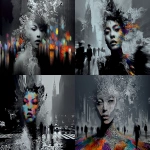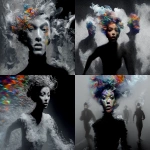Explore the Best AI Image Gallery

Beyond the Canvas: How AI-Driven Wearables Are Transforming Creative Expression
The creative landscape is undergoing a profound transformation, fueled by the convergence of artificial intelligence (AI) and wearable technology. This fusion is not merely about enhancing existing tools but about redefining the very nature of artistic expression. AI-driven wearables are empowering artists, designers, and creators to transcend traditional boundaries, blurring the lines between physical and digital realms.
A New Era of Artistic Expression
Imagine a world where your thoughts and emotions can be translated into tangible art forms in real time. This is the promise of AI-powered wearables. By leveraging sensors, motion tracking, and sophisticated algorithms, these devices capture biometric data such as heart rate, brainwaves, and even muscle movements. This raw data is then processed by AI to generate unique visual patterns, soundscapes, or interactive experiences.
Applications Across Creative Fields
- Digital Art: Wearable sensors can translate an artists emotions into mesmerizing digital paintings that evolve and shift with their feelings.
- Music Composition: AI-powered wearables can analyze a musicians playing style and generate intricate melodies or rhythmic patterns, pushing the boundaries of musical collaboration.
- Fashion Design: Smart garments equipped with sensors can respond to the wearers movements, creating dynamic and interactive fashion experiences.
- Performance Art: Wearable technology can enhance live performances by adding layers of visual effects, responding to the performers actions, and engaging the audience in immersive ways.
Ethical Considerations in AI-Driven Creativity
While the potential of AI-powered wearables in creative fields is immense, it also raises important ethical considerations:
- Data Privacy: The collection and use of biometric data raise concerns about privacy and security. Robust safeguards are needed to ensure responsible data handling.
- Algorithmic Bias: AI algorithms can inherit biases from the data they are trained on, potentially leading to unfair or discriminatory creative outputs.
- Authenticity and Ownership: Questions arise about the authorship and ownership of creations generated by AI, particularly when human input is minimal.
Shaping the Future of Creativity
AI-driven wearables are poised to revolutionize the creative industry, offering unprecedented tools for artistic expression. As this technology evolves, it will be crucial to:
- Develop ethical guidelines and regulations that address data privacy, algorithmic bias, and intellectual property rights.
- Promote transparency in AI-powered creative processes, allowing users to understand how their data is used and the role of AI in the creative output.
- Encourage collaboration between artists, technologists, and ethicists to ensure that AI empowers creativity while respecting human values.
The future of creativity lies at the intersection of technology and human imagination. By embracing responsible innovation, we can unlock the full potential of AI-driven wearables to transform the way we create, experience, and interact with art.



](https://images.ai-img.art/thumbnails/150/bd056a4718c27444e064198762f8dc8ffa1f74f1afd7dcda8d5cb8b142797d6e.webp)


](https://images.ai-img.art/thumbnails/150/0ba0be922ab76af53f75ab90126ae2b18a600ee3b96941e8ab897a9f10594e5a.webp)



](https://images.ai-img.art/thumbnails/150/2ebdeb4f7db35100e5be5de9bc3e533a40d14e5feedefd7ffc586524a0f3ba8c.webp)









](https://images.ai-img.art/thumbnails/150/685ae68cfab93a7e59a71206867b060c45bd6fd3cd561c4fe60fca514b09c5f8.webp)




](https://images.ai-img.art/thumbnails/150/a3ed6513a6661aa3ee46e0c2924d1e8888854e91d8908de39db5590dc41f8d8f.webp)













](https://images.ai-img.art/thumbnails/150/ff09e32d2be011c0dd785984c5c1e47839ce551a31da1bde242860b30df2aa30.webp)





](https://images.ai-img.art/thumbnails/150/847809c77ca9a73b68bc190e6efb06fec87157685a243730d5a66a403b0e6e10.webp)
](https://images.ai-img.art/thumbnails/150/7cf5a08238f29c821f52bb4f63db48af0b7f633ff3b9f7253074d78ced9ff6f6.webp)


